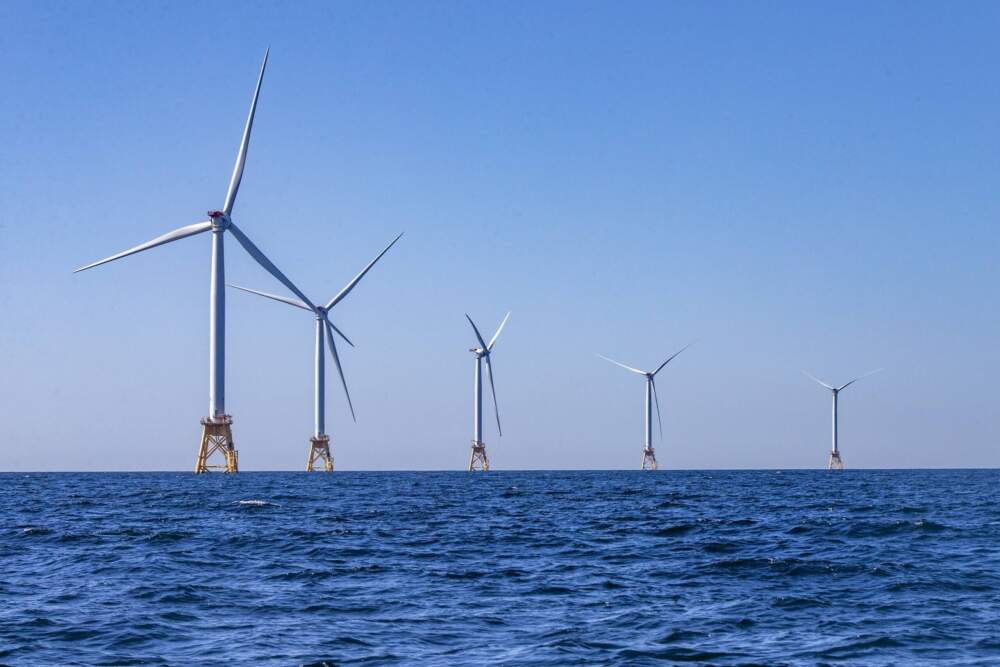Advertisement
Massachusetts partners with neighbors on offshore wind development

Amid a bruising stretch of project terminations and minimal competition, Massachusetts will try to reinvigorate the offshore wind industry by partnering with a pair of its neighbors.
Gov. Maura Healey announced Wednesday that leaders in Massachusetts, Rhode Island and Connecticut struck an agreement to solicit offshore wind power together in a multistate approach, a step the governor's office said is the first of its kind in the nation.
All three states are already in the process of acquiring a combined 6,000 megawatts of offshore wind energy capacity. A memorandum of understanding their officials signed Tuesday lays out a framework to authorize larger projects that would deliver the clean energy to more than one state at a time.
Officials are hopeful that by banding together, they can attract more interest from developers and keep projects locked in despite price changes and supply chain struggles that have derailed some plans.
Healey, who unveiled the agreement in her keynote address to an offshore wind conference in Boston on Wednesday, said the collaboration will help both states and energy developers.
Working together, the states can "align our procurements to leverage our collective buying power, lower project costs and maximize benefits for ratepayers across the region, and increase efficiencies and reduce project risk for offshore wind developers," Healey said.
"We can take advantage of the unique economic development opportunities available in each state, so you do not have to establish every component of the supply chain separately."
The memorandum leaves the states a lot of flexibility. The states can choose to pursue a multistate project or sign a contract alone, depending on the bids that come in.
Each of the states is still selecting its own projects based on its own laws, but the multistate approach opens the door for a developer to propose a project larger than the amount of megawatts any one state is seeking, according to an administration official.
Multistate bids are due Jan. 31, 2024, the same date that bids are due for the current Massachusetts procurement, an official said.
"I want Massachusetts to be the global leader in offshore wind, but it's also the case that we don't go it alone," Healey said to the offshore wind conference. "Especially in the this sector and with the challenges that you all face, true leadership requires collaboration."
Multistate proposals "must offer the same price" to all participating states or their electric companies, with a few exceptions for certain economic development investments, according to the memorandum.
All three states are already preparing to or are actively soliciting bids for wind developments. The Healey administration opened the fourth round of offshore wind procurement in Massachusetts on Aug. 30, seeking up to 3,600 megawatts of capacity with bids due in January.
Some of those projects would effectively backfill previous projects that fell through. A pair of 1,200-megawatt projects, Commonwealth Wind and SouthCoast Wind, each got state approval to pull out of their contracts with utility companies after concluding the projects were no longer financially viable in the wake of economic shifts.
Both developers have signaled they plan to resubmit bids for the projects in the next round with a goal of securing a higher price.
The liquidated contracts slashed the amount of wind energy lined up in Massachusetts by three-quarters, leaving only the 800-megawatt Vineyard Wind that is expected to begin generating some power this month. State law sets a target of 5,600 megawatts by 2027.
Healey on Wednesday signaled that her administration wants to be a "partner" that will help wind developers navigate a "rapidly changing environment."
"This is an anchor for our state's short-term and long-term success," Healey said. "I want you to know whatever turbulence this industry may be experiencing, we remain all-in as your partners."
Pedro Azagra, the CEO of offshore wind developer Avangrid, praised the move in a statement, saying, "This bold procurement strategy rises to the level of urgency the moment demands while providing offshore wind developers an opportunity to leverage economies of scale that will unlock more competitive bids and the potential for greater investments in local development and job creation."
Another factor Healey identified as key to building up offshore wind is federal funding. Massachusetts in May applied for up to $250 million from the U.S. Department of Energy to help upgrade onshore transmission, which would fund construction of two new "points-of-interconnection" in the state's southeastern corner to enable transmission of energy generated offshore, she said. Healey noted the state expects an award decision "soon."
The new tristate agreement is not the first time Massachusetts has taken a regional focus in the campaign to transition to clean energy and achieve net-zero greenhouse gas emissions by 2050.
Massachusetts is one of 12 states in the Regional Greenhouse Gas Initiative, a market-based cap-and-invest program that requires power plants to purchase a limited amount of allowances for the carbon dioxide they emit.
Former Gov. Charlie Baker tried to help launch a similar multistate program aimed at curbing transportation emissions, called the Transportation Climate Initiative, but it collapsed amid concerns about its expected impact on gasoline prices.
With reporting from WBUR's Miriam Wasser and Chris Lisinski of the State House News Service.